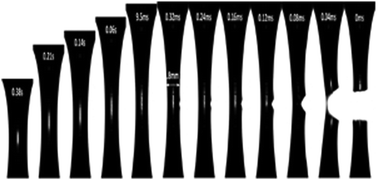Abstract
Ionomers are interesting due to their applications in coatings, adhesives, films and packaging materials. A study of the underlying mechanisms for fracture in ionomers is consequently of both practical as well as theoretical interest. In this study, we employ high speed imaging coupled with uniaxial extensional rheometry to delineate the mechanics leading to the brittle fracture of ionomer melts. When these ionomers are elongated at a rate higher than the inverse relaxation time of physical crosslinks, an edge fracture occurs at a critical stress. Parabolic fracture profiles provide evidence that the phenomenon is purely elastic and bulk dissipation has little impact on the crack profile. Experimental results are interpreted within the Griffiths theory for linear elastic materials and the de Gennes theory for viscoelastic materials.


 Please wait while we load your content...
Please wait while we load your content...